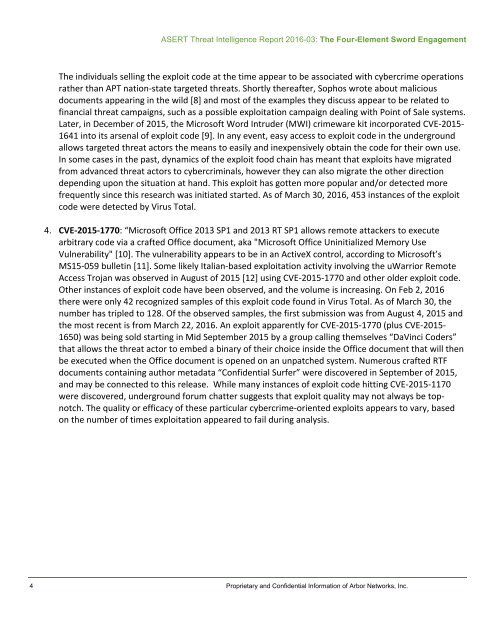ASERT-Threat-Intelligence-Report-2016-03-The-Four-Element-Sword-Engagement
ASERT-Threat-Intelligence-Report-2016-03-The-Four-Element-Sword-Engagement
ASERT-Threat-Intelligence-Report-2016-03-The-Four-Element-Sword-Engagement
You also want an ePaper? Increase the reach of your titles
YUMPU automatically turns print PDFs into web optimized ePapers that Google loves.
<strong>ASERT</strong> <strong>Threat</strong> <strong>Intelligence</strong> <strong>Report</strong> <strong>2016</strong>-<strong>03</strong>: <strong>The</strong> <strong>Four</strong>-<strong>Element</strong> <strong>Sword</strong> <strong>Engagement</strong><br />
<strong>The</strong> individuals selling the exploit code at the time appear to be associated with cybercrime operations <br />
rather than APT nation-‐state targeted threats. Shortly thereafter, Sophos wrote about malicious <br />
documents appearing in the wild [8] and most of the examples they discuss appear to be related to <br />
financial threat campaigns, such as a possible exploitation campaign dealing with Point of Sale systems. <br />
Later, in December of 2015, the Microsoft Word Intruder (MWI) crimeware kit incorporated CVE-‐2015-‐<br />
1641 into its arsenal of exploit code [9]. In any event, easy access to exploit code in the underground <br />
allows targeted threat actors the means to easily and inexpensively obtain the code for their own use. <br />
In some cases in the past, dynamics of the exploit food chain has meant that exploits have migrated <br />
from advanced threat actors to cybercriminals, however they can also migrate the other direction <br />
depending upon the situation at hand. This exploit has gotten more popular and/or detected more <br />
frequently since this research was initiated started. As of March 30, <strong>2016</strong>, 453 instances of the exploit <br />
code were detected by Virus Total. <br />
4. CVE-‐2015-‐1770: “Microsoft Office 2013 SP1 and 2013 RT SP1 allows remote attackers to execute <br />
arbitrary code via a crafted Office document, aka "Microsoft Office Uninitialized Memory Use <br />
Vulnerability" [10]. <strong>The</strong> vulnerability appears to be in an ActiveX control, according to Microsoft’s <br />
MS15-‐059 bulletin [11]. Some likely Italian-‐based exploitation activity involving the uWarrior Remote <br />
Access Trojan was observed in August of 2015 [12] using CVE-‐2015-‐1770 and other older exploit code. <br />
Other instances of exploit code have been observed, and the volume is increasing. On Feb 2, <strong>2016</strong> <br />
there were only 42 recognized samples of this exploit code found in Virus Total. As of March 30, the <br />
number has tripled to 128. Of the observed samples, the first submission was from August 4, 2015 and <br />
the most recent is from March 22, <strong>2016</strong>. An exploit apparently for CVE-‐2015-‐1770 (plus CVE-‐2015-‐<br />
1650) was being sold starting in Mid September 2015 by a group calling themselves “DaVinci Coders” <br />
that allows the threat actor to embed a binary of their choice inside the Office document that will then <br />
be executed when the Office document is opened on an unpatched system. Numerous crafted RTF <br />
documents containing author metadata “Confidential Surfer” were discovered in September of 2015, <br />
and may be connected to this release. While many instances of exploit code hitting CVE-‐2015-‐1170 <br />
were discovered, underground forum chatter suggests that exploit quality may not always be top-notch.<br />
<strong>The</strong> quality or efficacy of these particular cybercrime-‐oriented exploits appears to vary, based <br />
on the number of times exploitation appeared to fail during analysis. <br />
4 Proprietary and Confidential Information of Arbor Networks, Inc.


